

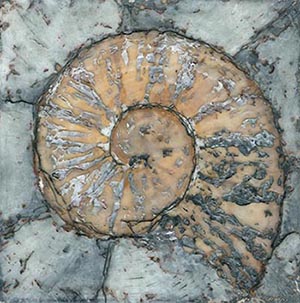
The evolution of fish is not studied as a single event since fish do not represent a monophyletic group. Fish first appeared during the Cambrian explosion, around 530 million years ago (Ma). Early fish from the fossil record are represented by a group of small, jawless, armored fish known as ostracoderms. Jawless fish lineages are mostly extinct. An extant clade, the lampreys may approximate ancient pre-jawed fish. The first jaws are found in Placoderm fossils. The diversity of jawed vertebrates may indicate the evolutionary advantage of a jawed mouth. It is unclear if the advantage of a hinged jaw is greater biting force, improved respiration, or a combination of factors.
Fish may have evolved from an animal similar to a coral-like sea squirt, whose larvae resemble primitive fish in important ways. The first ancestors of fish may have kept the larval form into adulthood (as some sea squirts do today), although perhaps the reverse is the case. Vertebrates, among them the first fishes, originated about 530 million years ago during the Cambrian explosion, which saw the rise in organism diversity. Read more ...
Ancient Blueprint For Human Bodies Discovered in Sea Anemones Science Alert - June 28, 2025
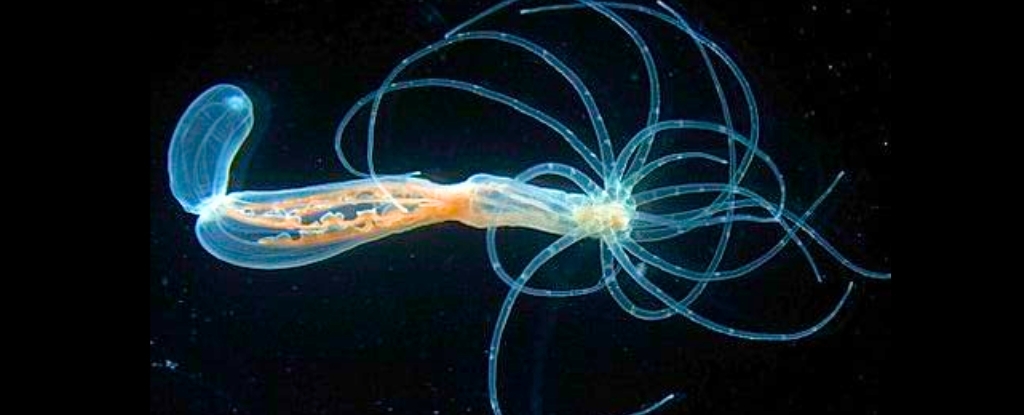
Sea anemones may look alien, but scientists just found out they're hiding an ancient body 'blueprint' – one that most animals, including humans, still follow. The discovery could shake up the timeline of evolution.
Rare sperm whale tooth unearthed at Copper Age mega-site in Spain sheds light on ancient human-sea connections PhysOrg - June 17, 2025
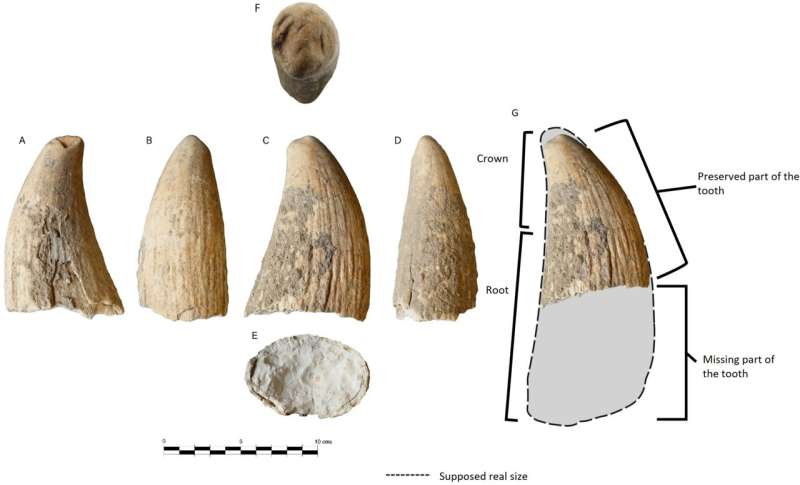
This rare find, dating back to a 5,300- to 4,150-year-old mega-village, is the first of its kind ever recorded in Late Prehistoric Iberia. The tooth belonging to the whale was probably found along the coast after spending time underwater, as shown by tiny bioerosion marks left by sea creatures. The researchers suggest that after it was collected, the tooth was carefully worked on by Copper Age craftspeople, possibly to extract pieces from it to craft personal ornaments or symbolically meaningful artifacts.
Ancient Four-Legged Whale Remains Discovered in Peru Could Rewrite Whale Evolution! Indian Defense Review - April 26, 2025

A fascinating new discovery has been made off the coast of Peru, where paleontologists have unearthed the remains of a previously unknown four-legged whale species. This remarkable find, which was made about 42.6 million years ago during the middle Eocene, is shedding new light on the evolutionary transition of whales from land-dwelling mammals to the aquatic giants we recognize today. As reported in Current Biology, the whale species, named Peregocetus pacificus, was found in the Playa Media Luna fossil site and represents a critical piece of the puzzle regarding whale migration patterns and early evolutionary development. The discovery marks an exciting milestone in our understanding of the evolution of cetaceans and their spread across the globe.
Extremely Rare Fool's Gold Fossils Show Soft Tissues Of 450-Million-Year-Old Sea Creature IFL Science - October 29, 2024
Alligator gar: The 'living fossil' that has barely evolved for 100 million years Live Science - October 5, 2024
This "living fossil" can grow as large as an alligator, has two rows of needle-sharp teeth, and such strong armor that it survived predatory dinosaurs. It lives in rivers, reservoirs and coastal bays in southwestern U.S. states, down to Veracruz, Mexico. With their long snout, thick armored scales, and two rows of piercing teeth, these huge fish could easily be mistaken for a ferocious gator - hence their common name: alligator gar.
New 210-Million-Year-Old Lungfish Species Lived When Dinosaurs Were Just Getting Started. These fish have endured for 420 million years, and you can see them alive today IFL Science - August 8, 2024
A fossil hunter has been honored with the most coveted of rewards among nature enthusiasts: getting a shiny new-to-science species in his name. Steve Edwards is also a safari guide in northern Zimbabwe, where he found a fossil of a curious fish that lived when the dinosaurs were just getting started around 210 million years ago.
246-Million-Year-Old Polar Sea Monster Is Older Than The Dinosaurs IFL Science - June 18, 2024
The fossil vertebra of a polar sea monster has been discovered that dates back 246 million years. Known as a nothosaur, the marine reptile lived just as the dinosaurs were getting started, and the fossil is the oldest of its kind ever found in the Southern Hemisphere.
Fossil Captures 155-Million-Year-Old Brittle Star Mid-Regeneration Science Alert - May 17, 2024
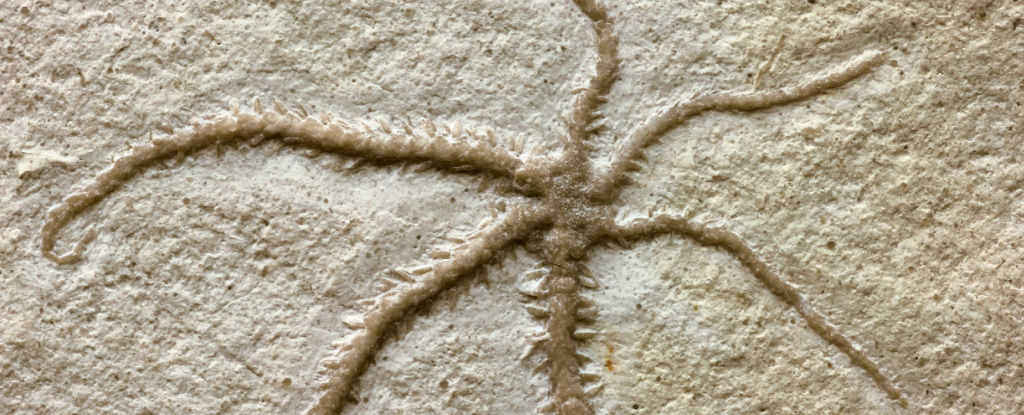
Scientists working in Germany have uncovered and described a six-armed brittle star, fossilized as it was partway through regenerating one body half. This truly exceptional fossil was excavated in 2018 from a limestone deposit in southern Germany that was once a deep lagoon filled with coral meadows and sponge beds. Now, it's a fossil garden littered with shark teeth and the remains of ancient pterosaurs, crustaceans, and crocodile-like creatures from the late Jurassic. The fossil is the first and only known specimen of what scientists have described as a new species of brittle star. Many modern-day brittle stars and some starfish reproduce via fissiparity, a process where the star 'splits' in half and each side regrows its missing parts. It's also known as clonal fragmentation, because the two new stars are clones of the original.
Exceptional Fossils Spill The Secrets Of 'Enigmatic' 10-Meter Sharks Found In Mexico IFL Science - April 24, 2024
Stunning Remains of Great White Shark's Giant Ancestors Reveal a Surprising Diet Science Alert - April 24, 2024
16 million years ago a different kind of Dolphin swam in the Amazon, And It Was a Giant Science Alert - March 23, 2024
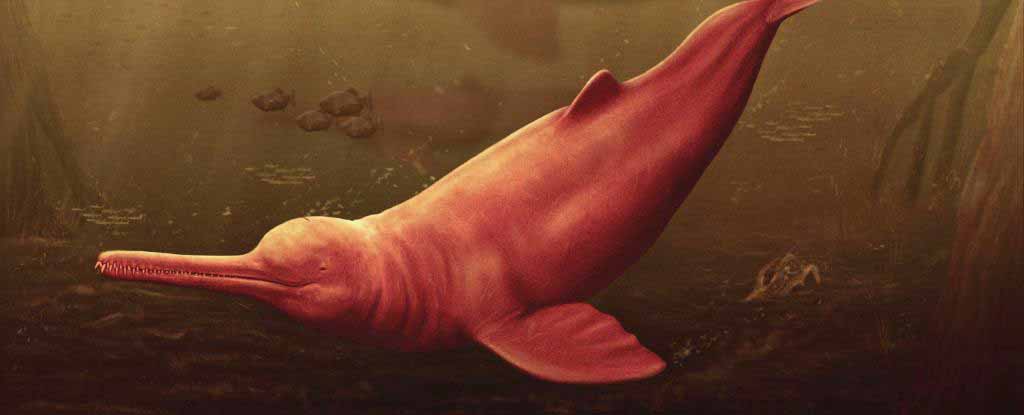
A dolphin that swam the waters of the Amazon basin 16 million years ago is a contender for the largest freshwater toothed whale the world has ever seen. The ancient beastie measured up to 3.5 meters (11.5 feet) in length, a good deal larger than the 2.7-meter (9-foot) pink Amazon river dolphins that feast on piranhas in the habitat today.
Octopuses Already Had The Oldest Known Sex Chromosomes 248 Million Years Ago IFL Science - March 7, 2024
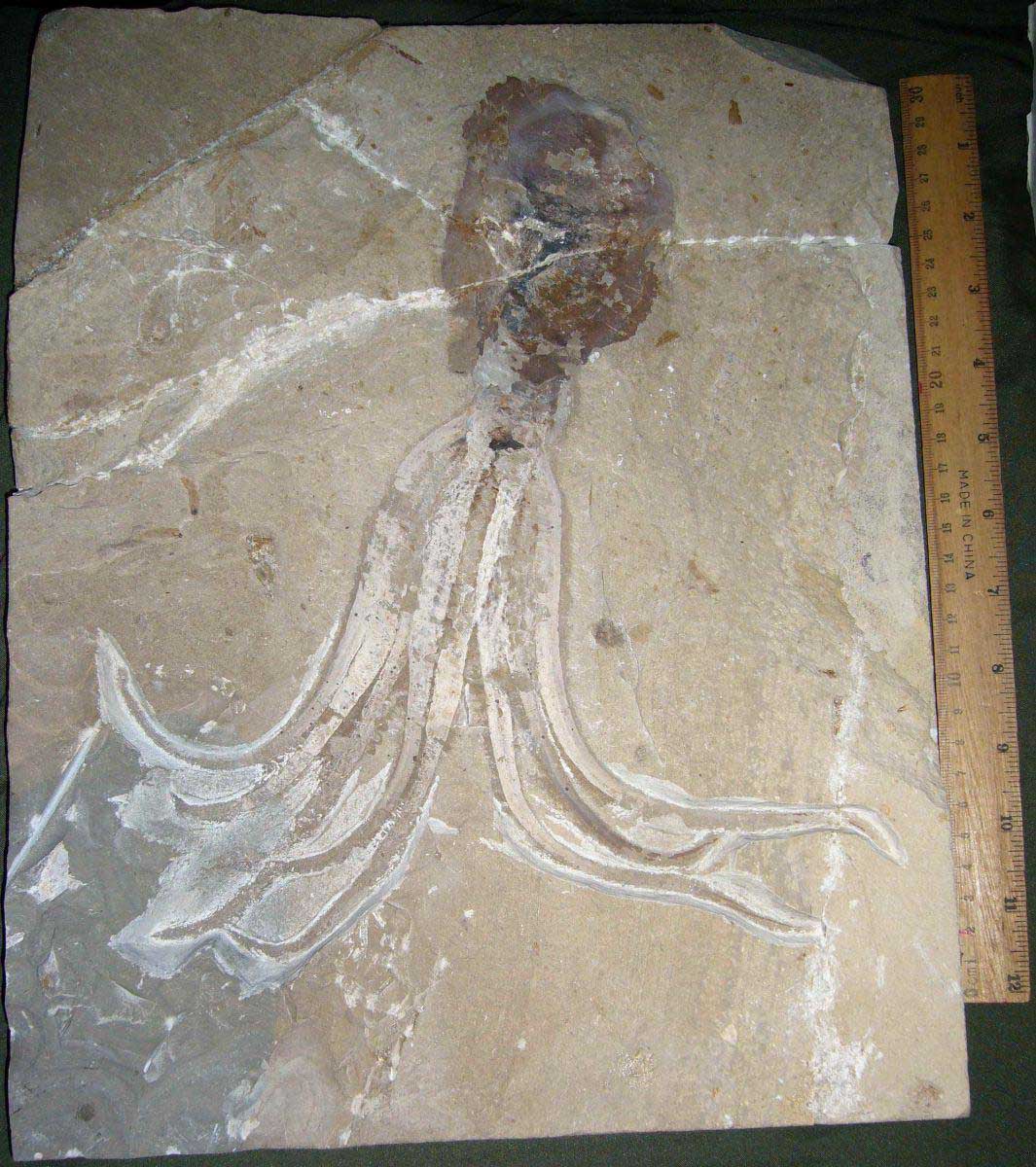
The chromosomes in cephalopods that determine whether they will be male or female have been in use for at least 248 million years – longer than those for any other animal equivalent we have found. The longevity contrasts with other animal classes, which change systems far more frequently.
Sharks Are 450 Million Years Old, Meaning They Were Here Before Trees Live Science - February 23, 2024
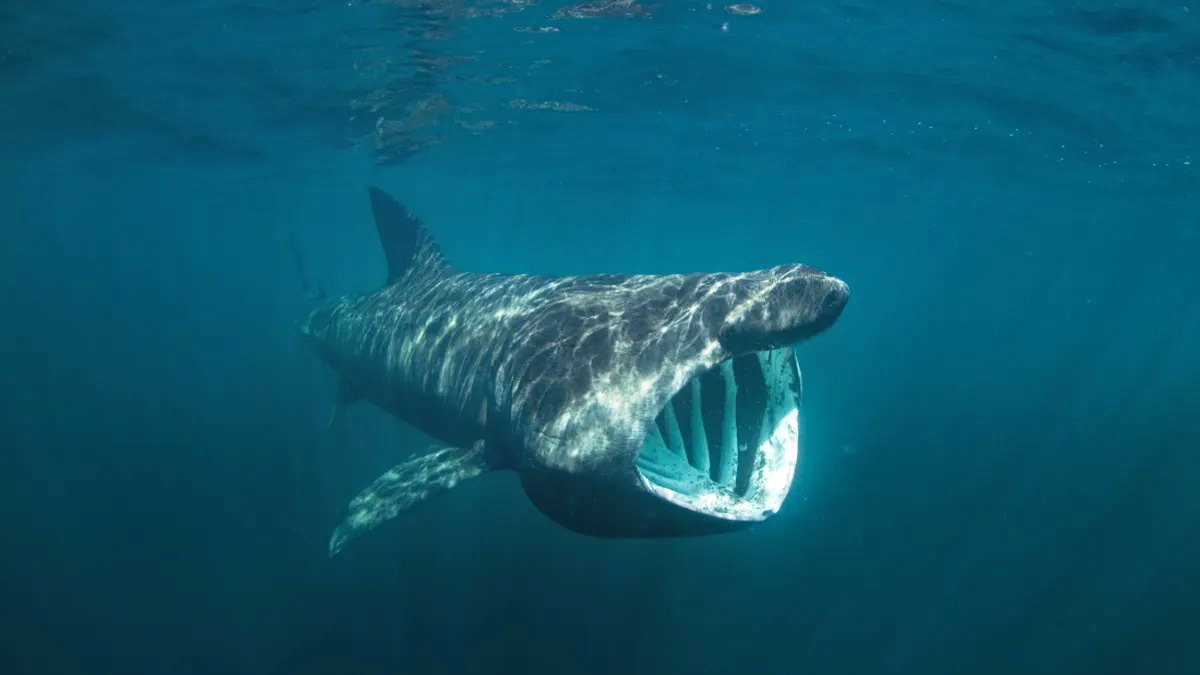
Sharks evolved around 450 million years ago, which means they’ve hitched a lift on planet Earth around the galaxy twice. If that’s not yet given you a fact-induced headache, it may tip you over to hear that it also means sharks were on Earth before trees, at a time when Saturn didn’t have rings yet.
Bizarre Prehistoric Predator Fish Breathed Air, Had Fangs And Four 'Limbs'
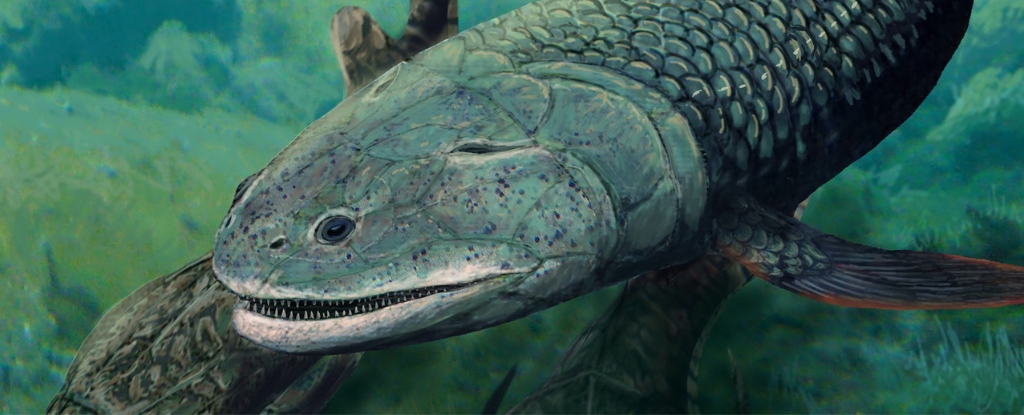
More than 380 million years ago, a sleek, air-breathing predatory fish patrolled the rivers of central Australia. Today, the sediments of those rivers are outcrops of red sandstone in the remote outback.
Spectacularly Preserved Jellyfish Found in 500-Million-Year-Old Rock Science Alert - August 2, 2023
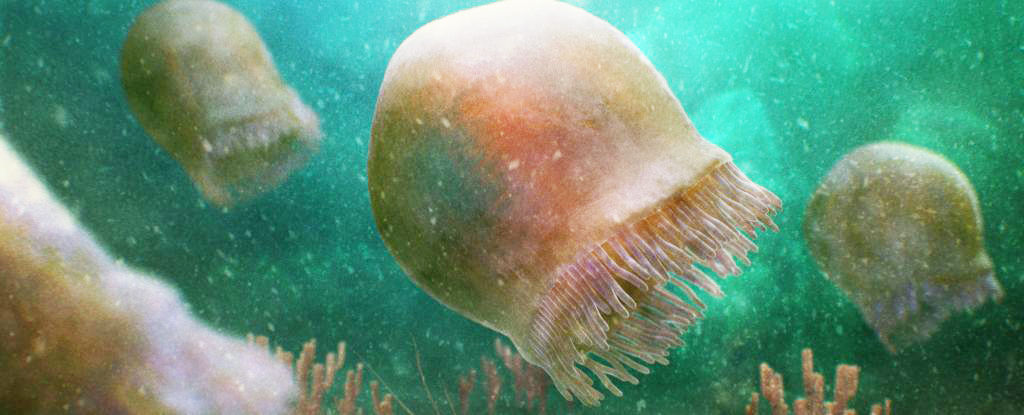
Something truly and wonderfully special has been found in a 505-million-year-old Canadian fossil bed. There, preserved in the especially fine silt of a lagerstatte, paleontologists found more than 170 exquisite fossils of ancient jellyfish that swam Earth's waters hundreds of millions of years before the first dinosaurs trod its soil.
Oops, this 300 million-year-old 'blob' fossil was upside down. It's not a jellyfish after all. Live Science - March 16, 2023
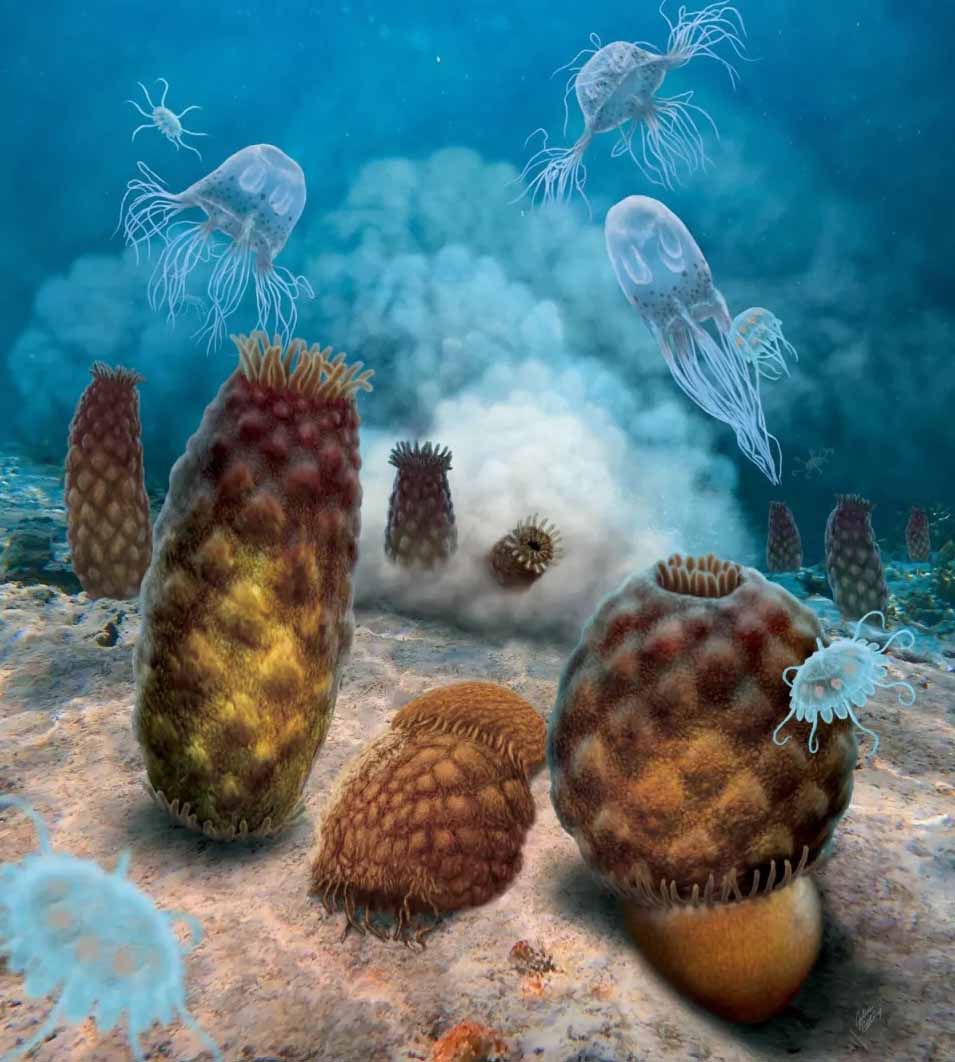
The fossil, first described in 1971, is famous in both scientific and amateur paleontology circles for being such an easy to find fossil, despite totally lacking a skeleton. But it turns out, the story of the creature was a bizarre case of mistaken identity, scientists reported in a study published March 8 in the journal Papers in Paleontology (opens in new tab).
The Mazon Creek fossil beds in Illinois, which formed 309 million years ago, capture a glimpse of water-dwelling species that lived during the warm, wet Carboniferous period (358.9 million to 298.9 million years ago). At that time, the area was an estuary, where silty fresh water from a river flowed into an ocean that covered much of modern-day North America. When plants and animals died in this estuary, often they would be quickly covered in sediment, which led to the impeccable fossilization of not only animal skeletons but also soft-bodied animals, like jellyfish, that typically don't fossilize well.
319-million-year-old fish preserves the earliest fossilized brain of a backboned animal PhysOrg - February 2, 2023
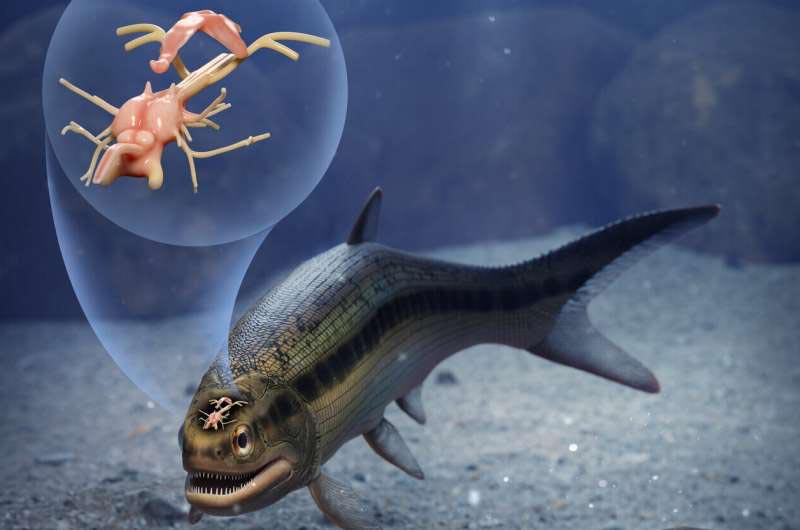
The CT-scanned skull of a 319-million-year-old fossilized fish, pulled from a coal mine in England more than a century ago, has revealed the oldest example of a well-preserved vertebrate brain. The brain and its cranial nerves are roughly an inch long and belong to an extinct bluegill-size fish. The discovery opens a window into the neural anatomy and early evolution of the major group of fishes alive today, the ray-finned fishes
A small clam, previously known only from fossils, has recently been found living at Naples Point, just up the coast from UC Santa Barbara PhysOrg - November 7, 2022
On an afternoon low tide in November 2018, Goddard was turning over rocks searching for nudibranch sea slugs at Naples Point, when a pair of small, translucent bivalves caught his eye.
This 560-Million-Year-Old Fossil Is Earth's Earliest Known Animal Predator Science Alert - August 1, 2022
It looked just like a relative of corals, anemones, and jellyfish from a sediment layer dated 20 million years before Cnidaria like these were thought to exist. It's nothing like anything ound in the fossil record at the time. Most other fossils from this time have extinct body plans and it's not clear how they are related to living animals. This one clearly has a skeleton, with densely packed tentacles that would have waved around in the water capturing passing food, much like corals and sea anemones do today.
Amazing Prehistoric Fish Fossil Looks Like It's 'Leaping Out of The Rock' Science Alert - July 30, 2022
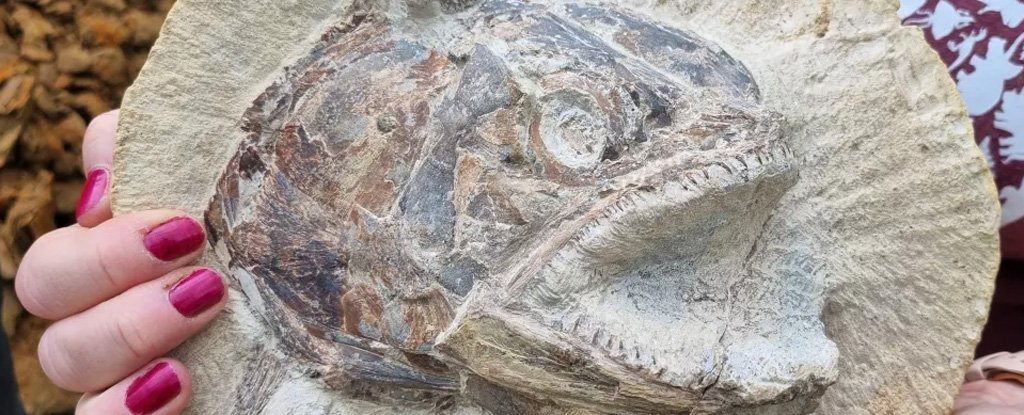
A farm in England was the unlikely source of a Jurassic jackpot: A treasure trove of 183 million-year-old fossils. On the outskirts of Gloucestershire in the Cotswolds, beneath soil that is currently trampled under the hooves of grazing cattle, researchers recently uncovered the fossilized remains of fish, giant marine reptiles called ichthyosaurs, squids, insects, and other ancient animals dating to the early part of the Jurassic period (201.3 million to 145 million years ago).
15-foot-long skeleton of extinct dolphin suggests parallel evolution among whales PhysOrg - July 9, 2020
Report offers a detailed description of the first nearly complete skeleton of an extinct large dolphin, discovered in what is now South Carolina. The 15-foot-long dolphin (Ankylorhiza tiedemani comb. n.) lived during the Oligocene - about 25 million years ago - and was previously known only from a partial rostrum (snout) fossil. The researchers say that multiple lines of evidence - from the skull anatomy and teeth, to the flipper and vertebral column - show that this large dolphin (a toothed whale in the group Odontoceti) was a top predator in the community in which it lived. Many features of the dolphin's postcranial skeleton also imply that modern baleen whales and modern toothed whales must have evolved similar features independently, driven by parallel evolution in the very similar aquatic habitats in which they lived.
Strange hollow ball-like structures found in 80-million-year-old fossils from species believed to be related to starfish and sea urchins PhysOrg - May 12, 2020
The scientists found the unusual structures known as buckyballs made up of a series of hexagons and pentagons in two species—the Uintacrinus socialis and Marsupites testudinarius. They believe the structures might have acted as a buoyancy chamber to allow the crinoid organisms to float in seawater, but also protect them.
Bonanza of Bizarre Cambrian Fossils Reveals Some of the Earliest Animals on Earth Live Science - March 21, 2019
A newfound fossil site in China is teeming with bizarre, primitive species that have never before been found any place on Earth. The bounty of creatures includes a spiny, segmented animal known as a mud dragon, and several jellyfish with preserved tentacles. Paleontologists discovered this treasure trove of fossils, which are incredibly well-preserved, along the banks of the Danshui River in southern China. The dozens upon dozens of creatures date to the Cambrian Period (490 million to 530 million years ago), when Earth's animal diversity was booming at an unprecedented pace. Scientists collected hundreds of specimens and identified fossils of 101 animals. Of those, more than half are new species that have yet to be described, the researchers reported in a new study.
Treasure trove of marine fossils from 'Cambrian explosion' found in China PhysOrg - March 22, 2019
The emergence of such a wide variety of phyla in such a short time has led to use of the term "Cambrian explosion" to describe it.
Fossilized slime of 100-million-year-old hagfish shakes up vertebrate family tree Science Daily - January 21, 2019
Paleontologists have discovered the first detailed fossil of a hagfish, the slimy, eel-like carrion feeders of the ocean. The 100-million-year-old fossil helps answer questions about when these ancient, jawless fish branched off the evolutionary tree from the lineage that gave rise to modern-day jawed vertebrates, including bony fish and humans.
The fossil of a 180-million-year-old ichthyosaur from the Jurassic era has been discovered and it contains evidence of blubber and skin, making the creature more similar to modern-day dolphins than previously thought New York Post - December 6, 2018
The creature was likely warm-blooded and potentially could use its coloration to help it hide from predators.
Rare fossil of an Ichthyosaur that was pregnant with octuplets shows the aquatic reptiles gave birth to live young rather than laid eggs 180 million years ago Daily Mail - April 5, 2018
The rare fossil of a pregnant Ichthyosaur with the remains of up to eight tiny embryos between its ribs reveals how these animals were giving birth 180 million years ago. These aquatic reptiles gave birth to live young, rather than laying eggs, and did not need to return to land, even to breed. The huge animals, which remained at the top of the food chain for millions of years during the Jurassic period, developed a streamlined, fish-like form built for speed. The fossil of the incredible three-metre long (ten-foot long) aquatic reptile was found by paleontologists near Whitby, North Yorkshire in 2010. Only five ichthyosaur specimens from Britain have ever been found with embryos and none with this many.
New postcranial skeleton of ancient dolphin Albertocetus meffordum found in South Carolina PhysOrg - November 9, 2017
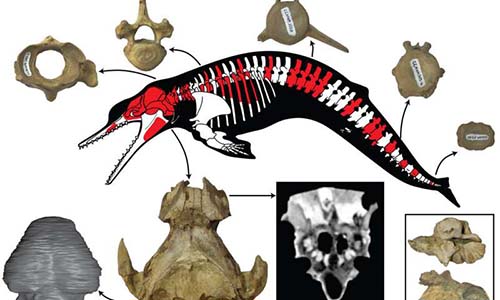
Previous research has shed light on the early evolutionary history of toothed whales, and particularly xenorophid dolphins - the earliest group of echolocating dolphins. Since the archaeological record for Xenorophidae is very limited, prior studies have focused on the crania or earbones of xenorophid dolphins. Four of the specimens belonged to the xenorophid Albertocetus meffordorum, and one contained a partial skeleton including ribs, vertebrae, and chevrons as well as a partial skull and mandible. Since these specimens were collected from formations dating to the Oligocene (33.9 million to 23 million years before the present), this finding extends the known evolutionary history for this group.
Largest Ichthyosaurus (fish) was pregnant mother, say paleontologists PhysOrg - August 28, 2017
Scientists from the UK and Germany have discovered the largest Ichthyosaurus on record and found it was pregnant at the time of death. The new specimen is estimated to be between 3 and 3.5 m long and is an adult female. Ichthyosaurs were a highly successful group of sea-going reptiles that became extinct about 90 million years ago. Often misidentified as swimming dinosaurs, these reptiles appeared before the first dinosaurs had evolved. The largest species of ichthyosaur grew to over 20 m in length. The new specimen was originally discovered on the Somerset coast, during the mid-1990s, and is from the Early Jurassic, roughly 200 million years old. However, the specimen remained unstudied until it wound up in the collections of the Lower Saxony State Museum in Hannover, Germany.
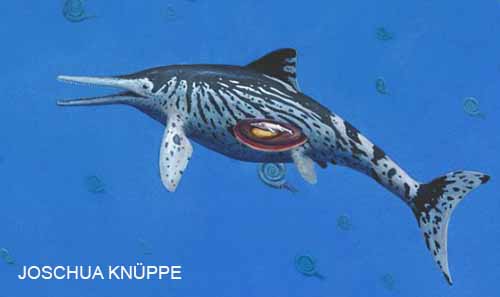
'Sea dragon' fossil is 'largest on record' BBC - August 28, 2017
The fossil of a marine reptile ''re-discovered'' in a museum is the largest of its kind on record, say scientists. The ''sea dragon'' belongs to a group that swam the world's oceans 200 million years ago, while dinosaurs walked the land. The specimen is the largest Ichthyosaurus to be described, at more than three metres long. It was discovered on the coast of England more than 20 years ago, but has remained unstudied until now.
Ancient 'Strange-Face' Dolphin Used Its Snout to Vacuum Up Food Live Science - August 23, 2017
A now-extinct dwarf dolphin whose name means "weaponless-snouted strange face" may have once used its toothless mouth to suck up fish and squid, a new study finds.The finding suggests that modern dolphins and whales developed bizarre forms of feeding within only a few million years after they evolved, the researchers said. Divers hunting for shark teeth found the skull fossil of a dolphin at the bottom of the Wando River near Charleston, South Carolina. Based on the layers of sandy limestone in which the bone was discovered, the scientists determined that the fossil is about 28 million to 30 million years old.
Desert Fossils Reveal 540-Million-Year-Old Jellyfish 'Graveyard' Live Science - August 7, 2017
540 million years ago, seaside sand contained densely packed microbial communities, which created a gooey glue that was excellent for preserving impressions of ocean creatures left high and dry by retreating waves.
New species of bus-sized fossil marine reptile unearthed in Russia Science Daily - May 25, 2017
A new species of a fossil pliosaur (large predatory marine reptile from the 'age of dinosaur') has been found in Russia and profoundly change how we understand the evolution of the group, says an international team of scientists. Spanning more than 135 Ma during the 'Age of Dinosaurs', plesiosaur marine reptiles represent one of longest-lived radiations of aquatic tetrapods and certainly the most diverse one. Plesiosaurs possess an unusual body shape not seen in other marine vertebrates with four large flippers, a stiff trunk, and a highly varying neck length. Pliosaurs are a special kind of plesiosaur that are characterized by a large, 2m long skull, enormous teeth and extremely powerful jaws, making them the top predators of oceans during the 'Age of Dinosaurs'. Spanning more than 135 Ma during the 'Age of Dinosaurs', plesiosaur marine reptiles represent one of longest-lived radiations of aquatic tetrapods and certainly the most diverse one. Plesiosaurs possess an unusual body shape not seen in other marine vertebrates with four large flippers, a stiff trunk, and a highly varying neck length. Pliosaurs are a special kind of plesiosaur that are characterized by a large, 2m long skull, enormous teeth and extremely powerful jaws, making them the top predators of oceans during the 'Age of Dinosaurs'.
The Best Fossil Octopus Ever Found Scientific American - March 6, 2017
A good cephalopod fossil is hard to find. Although ammonite shells, belemnite guards and other indicators of hard body parts are abundant in the fossil record, paleontologists seldom get to see the characteristic soft-tissue anatomy of these many-armed swimmers. Finds are so rare that one from 1982 still stands out: a 165-million-year-old fossilized octopus uncovered in France.
Paleontologists classify mysterious ancient cone-shaped sea creatures Science Daily - January 11, 2017
One branch on the tree of life is heavier as a team of scientists has determined what a bizarre group of extinct cone-shaped animals actually are. Known as hyoliths, these marine creatures evolved over 530 million years ago and are among the first known to have external skeletons. Long believed to be molluscs, a new study shows a stronger relationship to brachiopods -- a group with a rich fossil record though few species living today.
Early fossil fish from China shows where our jaws came from Science Daily - October 20, 2016
Where did our jaws come from? The question is more complicated than it seems, because not all jaws are the same. In a new article, palaeontologists from China and Sweden trace our jaws back to the extinct placoderms, armoured prehistoric fish that lived over 400 million years ago.
New species of fossil dolphin found BBC - August 17, 2016
Scientists have identified a new species of dolphin that lived 25 million years ago. The extinct animal has been described through re-examination of a specimen that's been in a museum collection since 1951. Researchers think it is a relative of the endangered South Asian river dolphin, offering clues to the evolutionary history of modern species. The findings have been published in the journal open access PeerJ. The fossil, a partial skull about 22cm (9ins) long, was discovered in southeastern Alaska by geologist Donald J Miller. It then spent decades in the collection of the Smithsonian Museum of Natural History in Washington DC. The dolphin swam in sub-arctic marine waters about 25 million years ago, according to the new study's authors Alexandra Boersma and Nicholas Pyenson, who are based at the Smithsonian.
Skull analysis of Qingmendous offers insight into creatures between pre-lobed fish and tetrapods PhysOrg - June 6, 2016
A team of researchers working at the Chinese Academy of Sciences has uncovered new characteristics of Qingmendous, an Onychodont that lived during the time between fish without lobed fins and tetrapods. In their paper published in the journal Science Advances, the team describes their study of the fish and discuss its possible place in the evolutionary history of the creatures that eventually made their way onto land
Strange sea-dwelling reptile fossil hints at rapid evolution after mass extinction PhysOrg - May 23, 2016
Two hundred and fifty million years ago, life on earth was in a tail-spin - climate change, volcanic eruptions, and rising sea levels contributed to a mass extinction that makes the death of the dinosaurs look like child's play. Marine life got hit hardest - 96% of all marine species went extinct. For a long time, scientists believed that the early marine reptiles that came about after the mass extinction evolved slowly, but the recent discovery of a strange new fossil brings that view into question.
520-million-year-old fossilized nervous system is most detailed example yet found PhysOrg - February 29, 2016
Researchers have found one of the oldest and most detailed fossils of the central nervous system yet identified, from a crustacean-like animal that lived more than 500 million years ago. The fossil, from southern China, has been so well preserved that individual nerves are visible, the first time this level of detail has been observed in a fossil of this age. The findings are helping researchers understand how the nervous system of arthropods - creepy crawlies with jointed legs - evolved. Finding any fossilized soft tissue is rare, but this particular find represents the most detailed example of a preserved nervous system yet discovered.
Discovery of new fossil species reveals unique binocular vision of the first ancient marine reptile PhysOrg - December 9, 2015
An international research partnership is revealing the first mosasaur fossil of its kind to be discovered in Japan. Not only does the 72-million-year-old marine reptile fossil fill a biogeographical gap between the Middle East and the eastern Pacific, but also it holds new revelations because of its superior preservation.
Bizarre Ancient Sea Creature Was Well-Armed for Feeding Live Science - November 29, 2015
A bizarre creature that looks like nothing alive on Earth today probably used its unique shape to collect drifting particles from the ocean to feed on, new research finds. Tribrachidium was a denizen of the shallow seas about 550 million years ago, during the late Ediacaran period. It looked like a disc with three tentaclelike arms protruding from its flat top. Oddly, Tribrachidium had three-fold symmetry, meaning three segments were mirror images of each other. For comparison, humans have two-fold, or bilateral, symmetry, and starfish have five-fold symmetry. Nothing alive today has three-fold symmetry. Because we have no obvious modern comparison, that's made it really hard to work out what this organism was like when it was alive — how it moved, if it moved, how it fed, how it reproduced.
End of the dinosaurs gave rise to the modern 'Age of Fishes,' researchers find PhysOrg - June 30, 2015
A pair of paleobiologists from Scripps Institution of Oceanography, UC San Diego have determined that the world's most numerous and diverse vertebrates - ray-finned fishes - began their ecological dominance of the oceans 66 million years ago, aided by the mass extinction event that killed off dinosaurs. Mammals evolved 250 million years ago but didn't become really important until after the mass extinction. Ray-finned fishes have the same kind of story. The lineage has been around for hundreds of millions of years, but without the mass extinction event 66 million years ago, it is very likely that the oceans wouldn't be dominated by the fish we see today.
Four hundred million year old fish fossil has earliest example of teeth PhysOrg - June 24, 2015
A pair of researchers has found what appears to be the earliest known example of a creature sporting teeth. After much research, scientists have come to believe that modern teeth, regardless of species, originated from scales on fish - this new research appears to confirm that theory and also offers some new insights into how it was that teeth came to exist.
Fossil ancestor shows sharks have a bony past PhysOrg - May 29, 2015
Most people know that sharks have a distinctive, all-cartilage skeleton, but now a fossil from Western Australia has revealed a surprise 'missing link' to an earlier, more bony form of the fish.
Something out of 'Alien': Rare frilled shark caught off Australian coast CNN - January 22, 2015
It looks like something out of "Alien" but has more in common with "Jurassic Park." It's a rare frilled shark that has been caught by a fisherman in Australia, where no one remembers ever seeing one caught before. With a mouth packed full of needle-like teeth and a body like an eel's, the 6-foot-long frilled shark is sometimes described as a fish "fossil" that dates back 80 million years.
Brain of world's first known predators discovered Science Daily - July 17, 2014
Scientists have found the fossilized remains of the brain of the world's earliest known predators, from a time when life teemed in the oceans but had not yet colonized the land. The discovery reveals a brain much simpler than those known in some of the animal's prey and helps answer questions surrounding the evolution of arthropods. The find for the first time identifies the fossilized brain of what are considered the top predators of their time, a group of animals known as anomalocaridids, which translates to "abnormal shrimp." Long extinct, these fierce-looking arthropods were first discovered as fossils in the late 19th century but not properly identified until the early 1980s. They still have scientists arguing over where they belong in the tree of life.
Oldest ionoscopiform fish found from the Middle Triassic of South China PhysOrg - June 3, 2014
Ionoscopiform fishes have been known only from the Late Jurassic of Europe and the Early Cretaceous of the New World, although potential ionoscopiforms based on poorly preserved specimens, questionably assigned in the genus Ophiopsis, have been reported from the Middle Triassic (Ladinian) of Italy and Austria. The Ionoscopiformes are extinct marine halecomorphs, and the Halecomorphi are a major subdivision of the ray-finned fishes. Although living halecomorphs are represented solely by the freshwater bowfin, Amia calva, this clade has a rich fossil history, and the resolution of interrelationships among extinct members is central to the problem of understanding the origin of the Teleostei, the largest clade of extant vertebrates.
Ancient 'Fish Lizard' Graveyard Discovered Beneath Melting Glacier Live Science - May 28, 2014
Dozens of nearly complete skeletons of prehistoric marine reptiles have been uncovered near a melting glacier in southern Chile. Scientists found 46 specimens from four different species of extinct ichthyosaurs. These creatures, whose Greek name means "fish lizards," were a group of large, fast-swimming marine reptiles that lived during the Mesozoic Era, about 245 million to 90 million years ago. The newly discovered skeletons are from both embryos and adults. The creatures, likely killed during a series of catastrophic mudslides, were preserved in deep-sea sediments that were later exposed by the melting glacier.
180-Million-Year-Old Fossils Revealed in Jurassic Deep Sea Live Science - May 21, 2014
Ancient fossils now reveal that the deep sea may be the origin of many lineages of sea creatures found closer to the surface, such as a number of sea stars, sea urchins and snails, researchers say. These new findings suggest the deep sea has played a much greater role in producing and preserving diversity in marine life than once thought, scientists added. The deep sea was long thought to be a lifeless desert. Intense research in the last few decades, however, has revealed that it actually supports one of the highest levels of biodiversity on Earth.
Off to See the Wizard? Ancient Fossils Had Heart and Brain Live Science - April 7, 2014
The fossil of an extinct marine predator that lay entombed in an ancient seafloor for 520 million years reveals the creature had a sophisticated heart and blood-vessel system similar to those of its distant modern relatives, arthropods such as lobsters and ants, researchers report today. The cardiovascular system was discovered in the 3-inch-long (8 centimeters) fossilized marine animal species called Fuxianhuia protensa, which is an arthropod from the Chengjiang fossil site in China's Yunnan province. It is the oldest example of an arthropod heart and blood vessel system ever found.
Ancient shrimp-like animals had 'modern' hearts and blood PhysOrg - April 7, 2014
>
In international team of researchers has discovered the earliest known cardiovascular system, and the first to clearly show a sophisticated system complete with heart and blood vessels, in fossilized remains of an extinct marine creature that lived over half a billion years ago. The finding sheds new light on the evolution of body organization in the animal kingdom and shows that even the earliest creatures had internal organizational systems that strongly resemble those found in their modern descendants.
Counting calories in the fossil record PhysOrg - March 26, 2014
>
Starting about 250 million years ago, at the end of the Permian period, brachiopod groups disappeared in large numbers, along with 90 percent of the planet's species. Today, only a few groups, or genera, of brachiopods remain. Most people won't be familiar with brachiopods. They're pretty rare in the modern ocean. Why one group of shelled animals thrived while the other barely survived is one of the great mysteries in paleontology. A popular theory, based on diversity and abundance data from the fossil record for the two groups, is that bivalves simply outcompeted brachiopods. But a new study by Payne and other researchers that looks at the issue from an energy standpoint paints a different picture.
Fossil porpoise has a chin for the ages PhysOrg - March 13, 2014
Scientists have identified a new species of ancient porpoise with a chin length unprecedented among known mammals and suggest the animal used the tip of its face to probe the seabed for food. Related to living crown porpoises, the extinct Californian porpoise, Semirostrum ceruttii, had an extension of its jaw called a symphysis the analogue of the human chin that measured 85 centimeters in the best-preserved specimen, researchers said. The typical symphysis of a crown porpoise measures one or two centimeters.
Parental care of the young from 450 million years ago PhysOrg - March 13, 2014
A portrait of prehistoric parenthood captured deep in the fossil record has been uncovered. The 'nursery in the sea' has revealed a species new to science – with specimens preserved incubating their eggs together with probable hatched individuals. As a result, the team has named the new species Luprisca incuba after Lucina, goddess of childbirth, and alluding to the fact that the fossils are ancient and in each case the mother was literally sitting on her eggs.
Researchers reveal new New Zealand fossil dolphin PhysOrg - January 22, 2014
A newly recognized fossil dolphin from New Zealand, dubbed Papahu taitapu, is the first of its kind ever found and may be a close relation to the ancestors of modern dolphins and toothed whales. Papahu lived 19–22 million years ago, and is one of the few dolphins to be reported globally dating to the start of the Miocene epoch. Judging from the size of its skull, Papahu was about two metres long, roughly the size of a common dolphin.
Strange Ancient Fish Had Front And Back Legs Live Science - January 14, 2014
The closest known relative of the ancestors of limbed animals such as humans likely evolved the foundation for rear legs even before the move to land, researchers say. This ancestor may have even been able to walk underwater, they added. These findings reveal that a key step in the evolution of hind limbs happened in fish, challenging previous theories that such appendages evolved only after the move to land. Scientists investigated fossils of a 375-million-year-old fish known as Tiktaalik roseae, discovered in 2004 in northern Canada's Ellesmere Island. Possessing a broad flat head and sharp teeth, Tiktaalik resembled a cross between a fish and a crocodile, growing to a length of 9 feet (2.7 meters) as it hunted for prey in shallow freshwater.
Tiktaalik: Iconic fossil's "rear end" described BBC - January 14, 2014
Scientists have finally managed to describe the back end of one of the key fossil finds of the past 10 years. Known as Tiktaalik, the 375-million-year-old creature is considered pivotal because it has many features that look half-way between fish and land animals. As such, it provides insight into life's evolutionary move from water into the terrestrial environment. The first specimens to be detailed only had foreparts, but the new fossils now show important rear elements.
Exceptional Fossil Fish Reveals New Evolutionary Mechanism for Body Elongation Science Daily - October 7, 2013
Snake and eel bodies are elongated, slender and flexible in all three dimensions. This striking body plan has evolved many times independently in the more than 500 million years of vertebrate animals history. Based on the current state of knowledge, the extreme elongation of the body axis occurred in one of two ways: either through the elongation of the individual vertebrae of the vertebral column, which thus became longer, or through the development of additional vertebrae and associated muscle segments.
Fossil Fish Is Oldest Creature With a Face Live Science - September 25, 2013
A newly discovered fish fossil is the earliest known creature with what might be recognized as a face. Entelognathus primordialiswas an ancient fish that lived about 419 million years ago in the Late Silurian seas of China. The finding provides a link between two groups of fishes previously thought to be unrelated, challenging long-held notions of how vertebrate faces evolved.
New flying fish fossils discovered in China BBC - October 31, 2012
New flying fish fossils found in China provide the earliest evidence of vertebrate over-water gliding strategy. Chinese researchers have tracked the "exceptionally well-preserved fossils" to the Middle Triassic of China (235-242 million years ago). The Triassic period saw the re-establishment of ecosystems after the Permian mass extinction. The fossils represent new evidence that marine ecosystems re-established more quickly than previously thought.
50-Legged Creature May Have Been Top Predator of Ancient Seafloor Live Science - November 9, 2011
An ancient cockroach-like creature nearly a foot long once skittered along the seafloor in what is now Canada, a new fossil find reveals. The fossil, a series of 500-million-year-old tracks, captured the movement of a large seafloor-dwelling creature with at least 25 pairs of legs. The animal was likely an arthropod called Tegopelte, a rare giant very rarely found fossilized. Arthropods are invertebrates with exoskeletons, a group that includes today's crustaceans and insects.
Fossil of Cretaceous-era squid found in Peru PhysOrg - January 20, 2011
Paleontologists said Thursday they discovered the 85-million-year-old fossil of a previously unknown squid species from the Cretaceous era in the high jungle region of northeastern Peru.
Oldest fossil shrimp preserved with muscles PhysOrg - November 9, 2010
The oldest known shrimp prior to this discovery came from Madagascar. This one is way younger, having an age of only 245 million years making the shrimp from Oklahoma 125 million years older. The fossil shrimp, having a length of about 3 inches, was found by fellow-paleontologist Royal Mapes. Feldmann and Schweitzer named the fossil after him: Aciculopoda mapesi. The discovery is also one of the two oldest decapods (ten footed) to which shrimp, crabs, and lobsters belong. The other decapod, Palaeopalaemon newberryi, is of similar age and was found in Ohio and Iowa. The shrimp from Oklahoma might, thus, be the oldest decapod on earth.
Mystery fossil is ancestor of squid BBC - May 27, 2010
The ancestors of modern squid may have existed half a billion years ago - a lot earlier than previously thought. In a new study, Canadian researchers identified a previously unclassifiable fossil that was long believed to belong perhaps to the shrimp family. They called it Nectocaris pteryx - a small soft-bodied cephalopod with two tentacles rather the eight or 10 seen in today's octopuses.
The findings make the ancestors of modern squid and octopuses at least 30 million years older.
Extinct giant shark nursery discovered in Panama PhysOrg - May 17, 2010
Excavations made possible by Panama's new Canal widening project reveal the history of the formation of the Isthmus of Panama and the flora and fauna present here over the last 20 million years. The six-foot-long babies of the world's biggest shark species, Carcharocles megalodon, frolicked in the warm shallow waters of an ancient shark nursery in what is now Panama, report paleontologists working at the Smithsonian Tropical Research Institute and the University of Florida.
Fossil find resolves ancient extinction mystery BBC - May 13, 2010
Researchers have revealed remarkably well preserved fossils of soft-bodied marine creatures that are between 470 and 480 million years old.
Jaws -- 4 million BC PhysOrg - March 16, 2010
Paleontologists have discovered evidence of how an extinct shark attacked its prey, reconstructing a killing that took place 4 million years ago. Such fossil evidence of behavior is incredibly rare, but by careful, forensic-style analysis of bite marks on an otherwise well-preserved dolphin skeleton, the research team, based in Pisa, Italy, have reconstructed the events that led to the death of the dolphin, and determined the probably identity of the killer: a 4 m shark by the name of Cosmopolitodus hastalis.
Ancient Amphibian Skull Discovered at Airport Live Science - March 15, 2010
A meat-eating amphibian that lived 300 million years ago may represent one of the earliest examples of land-based vertebrate life, scientists announced today. Researchers discovered the fossilized head of the ancient creature in 2004, near the Pittsburgh International Airport in western Pennsylvania. The ancient amphibian has been dubbed Fedexia striegeli after FedEx, which owns the land on which the fossil was found, and for Adam Striegel, who discovered the specimen while on a field trip as an undergrad at the University of Pittsburgh.
Prehistoric Whale Discovered On The West Coast Of Sweden Science Daily - June 8, 2009
Giant predatory shark fossil unearthed in Kansas BBC - February 24, 2010
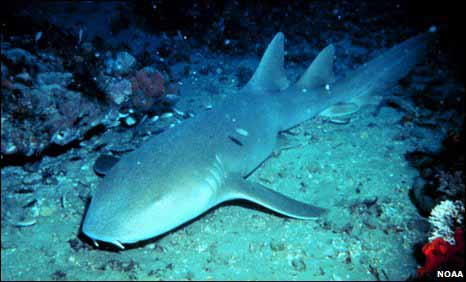
Giant Skull of 12m Pliosaur 'Sea Monster' Unearthed in England PhysOrg - October 28, 2009
The fossilized skull of a pliosaur, the largest marine reptile that ever lived, has been discovered along the Jurassic Coast World Heritage Site. This pliosaur lived in the Jurassic seas that covered Dorset 155 million years ago and was at least 12 metres long. The jaws were powerful enough to bite a small car in half.
Some Mollusks Thrived After Permian Extinction New York Times - August 27, 2009
The mass extinction that occurred at the end of the Permian period 252 million years ago was a body blow to marine organisms as the oceans became toxic (for reasons that are still cause for debate). Four out of five marine genera were wiped out, and recovery was slow. But not so slow, apparently, for one order of mollusks, the ammonoids. A study by French researchers in Science suggests that these shelled organisms (which look something like modern nautiluses but are related to squid and octopuses) diversified explosively in the first million years after the extinction. The general assumption has been that the mass extinction was so devastating that it took most genera at least five million years to recover.
Ancient Anthropods Used Borrowed Homes Live Science - August 23, 2009
Hermit crabs, a lineage some 200 million years old, may not have been the first to salvage mollusk shells for self-protection. Primitive arthropods were among the earliest animals to venture onto land - 500 million years ago - and they too recycled shells, according to new research. James W. Hagadorn of Amherst College in Massachusetts and Adolf Seilacher of Yale University analyzed Cambrian-period fossil tracks left on a sand flat by ancient arthropods in what is now central Wisconsin. The small imprints are in remarkably good shape: a microbial mat permeating the beach probably saved them from obliteration by waves.
Fossil bone bed helps reconstruct life along California's ancient coastline PhysOrg - June 8, 2009
>In the famed Sharktooth Hill Bone Bed near Bakersfield, Calif., shark teeth as big as a hand and weighing a pound each, intermixed with copious bones from extinct seals and whales, seem to tell of a 15-million-year-old killing ground.
The skeleton of a whale that died around 10,000 years ago has been found in connection with the extension of the E6 motorway in Strömstad. The whale bones are now being examined by researchers at the University of Gothenburg who, among other things, want to ascertain whether the find is the mystical "Swedenborg whale".
Cretaceous Octopus With Ink And Suckers -- The World's Least Likely Fossils? Science Daily - March 18, 2009
New finds of 95 million year old fossils reveal much earlier origins of modern octopuses. These are among the rarest and unlikeliest of fossils. The chances of an octopus corpse surviving long enough to be fossilized are so small that prior to this discovery only a single fossil species was known, and from fewer specimens than octopuses have legs.
Rare Fossil Octopuses Found Live Science - March 18, 2009
t's hard enough to find fossils of hard things like dinosaur bones. Now scientists have found evidence of 95 million-year-old octopuses, among the rarest and unlikeliest of fossils, complete with ink and suckers. The body of an octopus is composed almost entirely of muscle and skin. When an octopus dies, it quickly decays and liquefies into a slimy blob. After just a few days there will be nothing left at all. And that assumes that the fresh carcass is not consumed almost immediately by scavengers. The result is that preservation of an octopus as a fossil is about as unlikely as finding a fossil sneeze, and none of the 200 to 300 species of octopus known today had ever been found in fossilized form.
Arctic sea monster's giant bite BBC - March 17, 2009
A giant fossil sea monster found in the Arctic had a bite that would have been able to crush a 4x4 car, according to its discoverers.
Researchers say the marine reptile, which measured an impressive 15m (50ft) long, had a bite force of about 16 tonnes (35,000lbs).
The creature's partial skull was dug up last summer in the Arctic archipelago of Svalbard by a Norwegian-led team.
Dubbed "Predator X", it patrolled the oceans some 147 million years ago.
Preserved Shark Fossil Adds Evidence To Great White's Origins Science Daily - March 13, 2009
A new University of Florida study could help resolve a long-standing debate in shark paleontology: From which line of species did the modern great white shark evolve? The study in the March 12 issue of the Journal of Vertebrate Paleontology falls squarely into the mako camp. It concludes megalodon and modern white sharks are much more distantly related than paleontologists initially believed.
Scientists have discovered a highly unusual fish with fangs made of bone. BBC - March 11, 2009
BR>
Dubbed the "Dracula" fish, the creature is about 17mm (0.7 inches) long and has been found in only one Burmese stream. The researchers, from London's Natural History Museum (NHM), believe the fish lost its teeth over evolutionary time, but later evolved the bone fangs. Writing in the Royal Society's journal Proceedings B, they say the males use the fangs to jostle each other - but do not appear to draw blood.
Oldest fossil brain found in Kansas PhysOrg - March 2, 2009
When Alan Pradel of the Museum National d'Histoire Naturelle in Paris CAT scanned a 300-million-year-old fossilized iniopterygian from Kansas, he and his colleagues saw a symmetrical blob nestled within the braincase. This turned out to be the oldest brain found in fossil form, a wholly unexpected and rare discovery.
Fish fossil clue to origin of sex BBC - February 25, 2009
A fossil fish from Australia was one of the earliest known vertebrates to reproduce by fertilizing eggs inside the female, a study suggests. Nature journal says the ancient fish was carrying a 5cm-long embryo. The fertilization of eggs by sperm outside the mother's body - external fertilisation - is thought to have evolved before copulation. The fossil suggests the fertilization of eggs inside the female's body evolved sooner than previously thought.
Fossil fish shows oldest live birth PhysOrg - February 25, 2009
R>
A 380-million-year-old fossil fish that shows an unborn embryo and umbilical cord has been discovered, scientists report in the journal Nature. The extremely rare specimen shows incredible detail. The umbilical cord is attached to an area of small bones, corresponding to the embryo. This means the fish would have given birth to live young, known as viviparity and is the oldest record of this kind known.
Fossilized pregnant fish was one of the first animals to have sex PhysOrg - February 25, 2009
>
A pregnant fossil fish at the Natural History Museum in London has shed light on the possible origin of sex, according to a study published in Nature today by an international team including Museum scientists. The fossil is an adult placoderm, an extinct group of armored fish, and it contains a 5cm-long embryo. It is dated to the Upper Devonian period 350 million years ago and was found in the Gogo formation of western Australia.
Scientists say a fossil of a four-legged fish sheds new light on the process of evolution BBC - June 25, 2008
The creature had a fish-like body but the head of an animal more suited to land than water. The researchers' study, published in the journal Nature, says Ventastega curonica would have looked similar to a small alligator. Scientists say the 365-million-year-old species eventually became an evolutionary dead end.
Fossil reveals oldest live birth: Fish had umbilical cord BBC - May 28, 2008
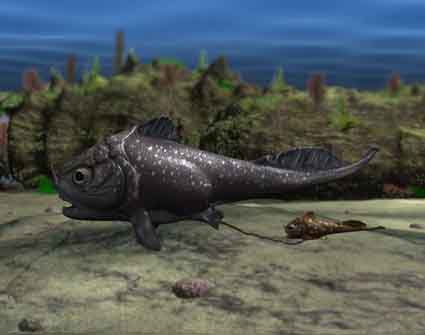
A fossil fish uncovered in Australia is the oldest-known example of a mother giving birth to live young, scientists have reported in the journal Nature. The 380 million-year-old specimen has been preserved with an embryo still attached by its umbilical cord. The find, reported in Nature, pushes back the emergence of this reproductive strategy by some 200 million years. Until now, scientists thought creatures from these times were only able to develop their young inside eggs.
Sea reptile is biggest on record BBC - February 27, 2008
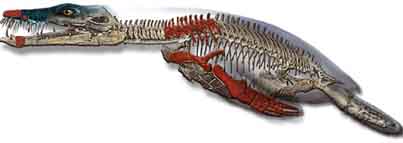
A fossilized "sea monster" unearthed on an Arctic island is the largest marine reptile known to science, Norwegian scientists have announced. The 150 million-year-old specimen was found on Spitspergen, in the Arctic island chain of Svalbard, in 2006.
'Nymph Of The Sea' Reveals Remarkable Brood Science Daily - November 24, 2006
Geologists have made an unusual discovery from over 425 million years ago ... hard boiled eggs! The scientists discovered the mother complete with her brood of some 20 eggs and 2 possible juveniles inside, together with other details of her soft part anatomy including legs and eyes. The team has made a digital image of the fossil - an ostracod (a relative of the shrimps) - which is preserved exceptionally in volcanic ash rocks in Herefordshire.
Ancient life in China limestone BBC - July 12, 2005
Researchers have found well-preserved fossils of organisms that lived on the ocean bed about 550 million years ago. The fossils, unearthed in Southern China, are of some of the earliest complex lifeforms known to science. Frondose vendobionts died out before the Cambrian explosion about 540 million years ago, when animals with bones and shells appeared. They are not closely related to any modern species but share similarities with fungi, lichen, and algae. Evidence of complex life older than 540 million years is hard to study. Many of the organisms that appeared in the Ediacaran Period (the time period between about 600 and 542 million years ago) had soft body parts that do not make an impression in rock.
Ancient deep-seafungus 'revived' in lab BBC - October 19, 2004
>
Fungus from a deep-sea sediment core that is hundreds of thousands of years old can grow when placed in culture, scientists have discovered. Indian researchers say the fungi come from sediments that are between 180,000 and 430,000 years old. The finding adds to growing evidence for the impressive survival capabilities of many microorganisms.
Ancient Sea Spider Fossils Discovered In Volcanic Ash Science Daily - October 2004
Volcanic ash that encased and preserved sea life in the Silurian age 425 million years ago near Herefordshire, UK has yielded fossils of an ancient sea spider, or pycnogonid, one of the most unusual types of arthropod in the seas today. Sea spiders are soft-bodied arthropods, found widely in modern oceans. For two-centuries there has been a controversy about the relationship of sea spiders to land spiders, scorpions, ticks and mites because of their unique body form. Sea spiders have a long proboscis and unusual limb structures used in mating and carrying brooding embryos. The fossil record of their relationship is sparse because of their delicate nature.
New Fossil Links Four-legged Land Animals To Ancient Fish Science Daily - April 2, 2004
>
How land-living animals evolved from fish has long been a scientific puzzle. A key missing piece has been knowledge of how the fins of fish transformed into the arms and legs of our ancestors. In this week's issue of the journal Science, paleontologists Neil Shubin and Michael Coates from the University of Chicago and Ted Daeschler from the Academy of Natural Sciences in Philadelphia, describe a remarkable fossil that bridges the gap between fish and amphibian and provides a glimpse of the structure and function changes from fin to limb. The fossil, a 365-million-year-old arm bone, or humerus, shares features with primitive fish fins but also has characteristics of a true limb bone. Discovered near a highway roadside in north-central Penn., the bone is the earliest of its kind from any limbed animal.
"It has long been understood that the first four-legged creatures on land arose from the lobed-finned fishes in the Devonian Period," said Rich Lane, director of the National Science Foundation's (NSF) geology and paleontology program. "Through this work, we've learned that fish developed the ability to prop their bodies through modification of their fins, leading to the emergence of tetrapod limbs."
Fossil may be earliest arm bone BBC - April 2004
>
A tiny fossil found by a road cutting in Pennsylvania, US, could be the earliest example of an arm bone. The 360-370-million-year-old humerus, or upper arm bone, indicates that limbs may have evolved for use in water and not to get around on land. It suggests the earliest limbed animals were fish navigating shallow rivers, but its place in the evolutionary tree is the subject of some controversy. US biologists have published details of the discovery in the journal Science
Giant sea fossil unearthed BBC - December 30, 2003
Eight to ten million years ago, South America's waters harbored a toothier, three-foot (one-meter) version of today's famed, flesh-eating piranhas. Alberto Cione, a paleontologist at Argentina's La Plata Museum, first noticed the evidence of Megapiranha pananensis (pictured in an artist's rendering)--an upper jaw with three unusually large and pointed teeth-in his collection in the 1980s. The remains had been discovered half a century earlier in a riverside cliff in northeastern Argentina. The creature, which measures 20 metres (65 ft) from nose to tail, was discovered by German and Mexican paleontologists. It has been nicknamed the "Monster of Aramberri" after the site in northeastern Mexico where it was dug up. Although many Liopleurodon remains have been unearthed before, none have been as complete as the Mexico discovery.
ANCIENT AND LOST CIVILIZATIONS